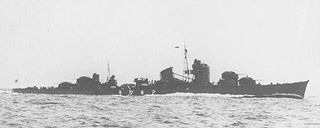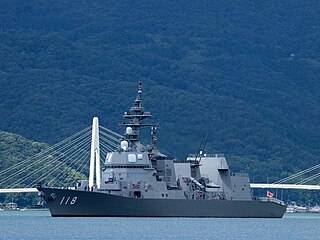Two Japanese destroyers have been named Fuyuzuki or archaically Fuyutsuki:
- Japanese destroyer Fuyutsuki, an Akizuki-class destroyer launched in 1944 and scrapped in 1948
- JS Fuyuzuki, an Akizuki-class destroyer launched in 2012
Two Japanese destroyers have been named Fuyuzuki or archaically Fuyutsuki:

JDS Teruzuki (DD-162) was a Japanese Akizuki-class destroyer. The vessel was laid down in 1958 and served as a front line warship with the Japan Maritime Self-Defense Force until 1986, and as an auxiliary until 1993.

Mark 32 Surface Vessel Torpedo Tubes is a torpedo launching system designed for the United States Navy.
Fuyutsuki may refer to:

Akizuki was the lead ship of her class of destroyer in the Imperial Japanese Navy.

Suzutsuki (涼月) was an Akizuki-class destroyer of the Imperial Japanese Navy. Her name means "Clear Moon ".
Wakatsuki (若月) was an Akizuki-class destroyer of the Imperial Japanese Navy. Her name means "Young Moon".

Fuyutsuki was an Akizuki-class destroyer of the Imperial Japanese Navy. Her name means "Winter Moon".

The Takanami-class destroyer is a class of destroyer serving with the Japan Maritime Self-Defense Force (JMSDF). This warship is the slightly modified class of second-generation, general-purpose destroyers of the JMSDF.

The Akizuki-class destroyer was a destroyer class built for the Japan Maritime Self-Defense Force (JMSDF) in the late 1950s. This class was planned to be a flotilla leader with the enhanced command and control capability, so sometimes this class was classified as the "DDC" unofficially.

The Akizuki class of destroyers of the Japan Maritime Self-Defense Force is intended to escort the Hyūga-class and Izumo-class helicopter destroyers, and safeguard the other Aegis-capable warships such as the Kongō class and Atago class. The destroyer provides defense against surface, airborne and undersea threats. The class was initially designated as "19DD", referring to a date on the Japanese calendar, specifically the 19th fiscal year of the Heisei period (2007).
Akizuki-class destroyer may refer to:
The Japanese name Akizuki may refer to:

The Akizuki-class destroyers was a class of destroyers of the Imperial Japanese Navy (IJN) built during World War II to complement the Kagerō class, primarily for the role of anti-aircraft screening for carrier battle groups. The class was also designated the Type-B Destroyer, from their plan name. During the war, the class proved to be a very capable multipurpose platform and was well regarded in the IJN.

Maizuru Naval Arsenal was one of four principal naval shipyards owned and operated by the Imperial Japanese Navy.
The Super Akizuki-class destroyer were a projected class of destroyer of the Imperial Japanese Navy (IJN), developed during the Second World War. The intention was to develop a faster destroyer based on the Akizuki class. The IJN Technical Department gave them the project number V7. However, the project was cancelled with none of the proposed ships being completed, because of the continued Japanese defeats.

The Asahi class of destroyers of the Japan Maritime Self-Defense Force is optimized for undersea warfare. The class was initially designated "25DD", referring to a date on the Japanese calendar, specifically the 25th fiscal year of the Heisei period (2013).
Three Japanese destroyers have been named Akizuki:
Three Japanese destroyers have been named Teruzuki:
Two Japanese destroyers have been named Suzutsuki:

JS Fuyuzuki (DD-118) is the fourth ship of Akizuki-class destroyers. She was commissioned on 13 March 2014.